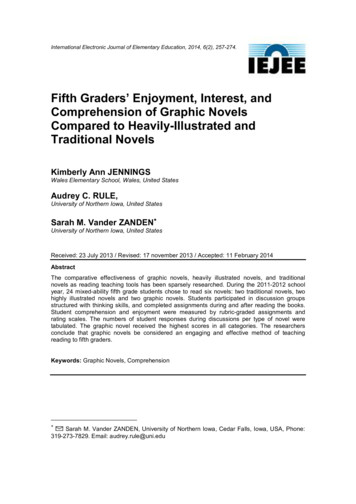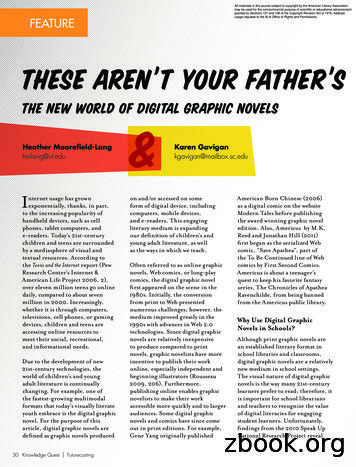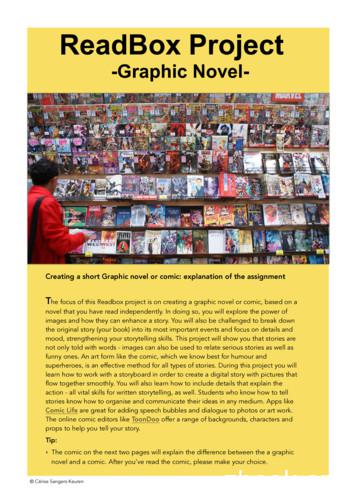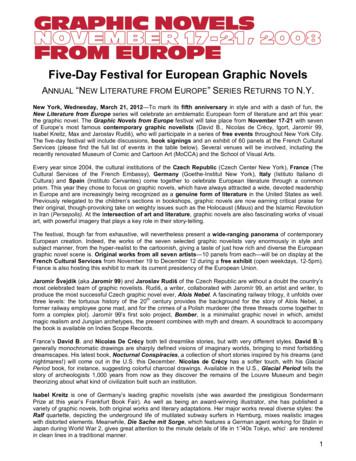Graphic Novels: Kyo Maclear’s Bookmark! Versatile, Layered .
4.95SUMMER 2015Vol. 38 no. 3RECOMMENDED BOOKS OPINIONS PROFILES NEWS REVIEWSGraphic Novels:Versatile, layeredreading for allKyo Maclear’sBig Themes inSmall PackagesReviews of over 35 books by Cybèle Young,Janet Gurtler, Wesley King, Charles de Lint and moreBookmark!the latestgraphic novels
FIRST NATIONCOMMUNITIESR E A DFirst Nation Communities Read&Periodical Marketers of CanadaCONGRATULATEFIRST NATIONCOMMUNITIESR E A DDarrell DennisAuthor of the 2015 – 2016First Nation Communities Read title selectionPeace Pipe Dreamspublished byandwinner of theAboriginal Literature Awardsponsored by Periodical Marketers of CanadaFirst Nation Communities ReadYour Go-to Resource for First Nations, Métis and Inuit ReadingRecommended by First Nation IRST NATIONCOMMUNITIESR E A DISBN (print): 978-1-77100-040-6ISBN (ebook): 978-1-77100-362-9
booknewsCONTENTS THIS ISSUE7Summer 2015 Volume 38 No. 3Seen at .Book Week inspiration! A page from author/ illustrator Anne Villeneuve’ssketchbook from her Nunavut visit for TD Canadian Children’s Book Week.Editor Gillian O’ReillyCopy Editor and Proofreader Mary Roycroft RanniDesign Perna Siegrist DesignAdvertising Michael WileThis informative magazine published quarterlyby the Canadian Children’s Book Centre is availableby yearly subscription.Single subscription – 24.95 plus sales tax(includes 2 issues of Best Books for Kids & Teens)Contact the CCBC for bulk subscriptions andfor US or overseas subscription rates.Summer 2015 (July 2015)Canadian Publication Mail Product SalesAgreement 40010217Published by the Canadian Children’s Book CentreISSN 1705 – 7809For change of address, subscriptions,or return of undeliverable copies, contact:The Canadian Children’s Book Centre40 Orchard View Blvd., Suite 217Toronto, ON M4R 1B9Tel 416.975.0010 Fax 416.975.8970Email info@bookcentre.ca Website www.bookcentre.caReview copies, catalogues and press releasesshould be sent to the Editor at: gillian@bookcentre.caor to Gillian O’Reilly c/o the above address.For advertising information, contact: Michael Wile atads@reviewcanada.ca or 416.531.14834Opinion: Aspirations, Opportunitiesand School LibrariesAnita Brooks Kirkland argues for the uniquevalue of school libraries in the context ofcurrent priorities for education.6News RoundupCOVER: Illustration by Julie Morstad fromThis Is Sadie. Text copyright 2015 Sara O’Leary,illustration copyright 2015 Julie Morstad.Reproduced with permission of the illustrator.For more information, Medium: Gouache, watercolour and pencil crayon.ABOUT THE Illustrator: Julie Morstad is anauthor, illustrator and artist living in Vancouver,British Columbia. Books she has illustrated forchildren include How To (which she also authored),When You Were Small, When I Was Small and SingingAway the Dark. She has been a recipient of theMarilyn Baillie Picture Book Award, the ElizabethMrazik-Cleaver Canadian Picture Book Award and theChristie Harris Illustrated Children’s Literature Prize.Her books have been shortlisted for many otherchildren’s literature awards.“Our Own Space”: Changing Visions ofCanada in Children’s Books; Mark yourcalendars for Get Published! seminar; Thanksto a retiring champion of Canadian books;Discover the Book Week Writing ContestWinners; Dawn Todd retires from CCBC;Sandra O’Brien becomes Outreach EducationCoordinator; Anne of Green Gables returnsto the screen in 2016; Call for submissions:18th annual Writing for Children Competition;“IBBY Silent Books, Final DestinationLampedusa” comes to Canada.7Seen at .A photographic look at book events8Keep Your Eye On. Susan White10Profile: Big Themes in Small PackagesKyo Maclear walks the fine line between“the pat and the poetic.”12Focus: Different, Versatile, Layered:Canadian Graphic Novels have evolvedinto a Staple for Young ReadersDr. Beverley Brenna and her students explorethe changing perceptions of graphic novels andtheir audiences.18Separately working togetherHow Liam O’Donnell and Mike Deas team upto create graphic novels.20Bookmark! Graphic NovelsNew titles in the genre.22The Classroom BookshelfScience and Social Studies Fun in PictureBooks.24Book Bits:World War II: Love, Loss and LoyaltyThree new books explore young people’s livesin wartime.26We RecommendReviews of the latest in fine Canadian booksfor children and teens.40Index of ReviewsSUMMER 2015 CANADIAN CHILDREN’S BOOK NEWS1
sediuGlavivruSfor Middle Readers“A wonderfully cheekyand smart read.”9781459807945 9.959781459804845 9.95—Ca nad ian Fam ily Mag azin e9781459805859 9.95“Sarcastic-yet-realistic A book that will grab many.”—Booklist Online“Packed tight with jokes, deliberatelyquirky scenes, and lovable characters.”“[A] laugh-out-loudfunny novel.”—School Library Journal9781459807556 9.95.959781459801479 9—VOYA “A rollicking good read, withadventures tumbling one after theother.Gleefully thrilling.”—Quill & Quire, starred
FROM THE EDITOR GILLIAN O’REILLYBoard of DirectorsDaryl Novak, PresidentTodd Kyle, Vice-PresidentLeigh Chalmers, TreasurerLisa DoucetNancy HartryFarzana KurwaShar LevineLeslie McCallumLynne MissenFelicia QuonRoland StringerStaffCharlotte Teeple Executive DirectorShannon Howe Barnes Program CoordinatorMeghan Howe Library CoordinatorCamilia Kahrizi Marketing and Website CoordinatorSandra O’Brien Outreach Education CoordinatorPatronsKit PearsonIan and Deb WallaceSponsorsAmazon.caFriesensHarperCollins CanadaRawlinson Moving & StorageSimon & Schuster CanadaTD Bank GroupFundersCanada Council for the ArtsCanadian Heritage (Canada Book Fund)Charles BaillieFleck Family FoundationManitoba Department of Culture,Heritage and TourismPEI Department of Educationand Early Childhood DevelopmentPEI Department of Tourism and CultureOntario Arts CouncilOntario Arts FoundationToronto Public LibraryYukon Department of EducationA funny thing about graphic novels, observed an editor at a seminar I attended manyyears ago, is that so many of them aren’t novels — they are memoirs or biographies orinteresting explorations of non-fiction topics. In recent years, however, the range of graphicnovels has expanded to include all sorts of fiction and non-fiction for readers whose agesrange from very young to adult.At the same time, as you will see in our “focus” article, there has been a change inthe attitude toward the audience for graphic novels. These books can no longer bepigeonholed as suitable for only certain types of readers. Dr. Beverley Brenna and her teamat the University of Saskatchewan make a strong case that graphic novels work for manydifferent kinds of readers. Their accompanying bibliography reminds us of the range anddiversity that has developed in Canadian graphic novels in the last decade, and CCBCLibrary Coordinator Meghan Howe’s “Bookmark!” adds some very recent titles tocomplement Dr. Brenna’s list.Have you ever wondered how graphic novel creators work? Who does what when?The team of Liam O’Donnell and Mike Deas offers us a glimpse into the process.When it comes to linking any kind of reader with any kind of books, teacher-librarians playa vital role. Anita Brooks Kirkland, former president of the Ontario Library Association,presents a strong case for teacher-librarians, which should be read by all.Plus, we have a profile of award-winning author Kyo Maclear and reviews of manynew books.Happy reading.Our ThanksThe work of the Canadian Children’s Book Centreis made possible through the generous support of ourmembers, volunteers, sponsors, funders and thecontinuing assistance of the Canada Council for the Arts,Writing and Publishing Section, and the PublicReadings Program.We acknowledge the financial support of theGovernment of Canada through the Department ofCanadian Heritage’s Canada Book Fund program.Your feedback is important!Email comments TO GILLIAN@BOOKCENTRE.CALike us! facebook.com/kidsbookcentreFollow us! @kidsbookcentreW W W. B O O K C E N T R E . C ASUMMER 2015 CANADIAN CHILDREN’S BOOK NEWS3
OPINION Anita Brooks KirklandAspirations and OpportunitiesAdvocacy for School Library ProgramsAt the recently held [OLA Superconference], I madethe argument that we can get hung-up on the moneywhen it comes to learning commons spaces. But itis first about mindsets — we need to embrace newways of learning and find ways for our space toreflect these changes and be the gathering placesfor all our learners. The thinking around thelearning commons is symbolizing the shifts we areseeing with learning throughout our schools.Chris Kennedy, Superintendent of Schools / CEO,West Vancouver School District, British ColumbiaThere has never been a more exciting time to be a teacherlibrarian. The foundations of teacher-librarianship have never been more closely aligned with the aspirations of today’seducation leaders and governments. New thinking about theschool library as a learning commons, where collaboration andinnovation drive learning within today’s complex informationenvironment, has particular relevance for today’s learners.I say all of this, fully realizing the challenges of advocating for school libraries in Canada. Too often, that advocacydwells on crisis thinking, unwittingly creating a sense thatit’s all too little, too late. Frequently, advocacy for school libraries draws on nostalgia and the outdated notion that librariesare sacred and deserve to exist, just because. Today’s librariesexist to help realize the aspirations of their constituent communities. Libraries in all sectors, including K-12 education,are reinventing themselves in powerful ways. School libraryadvocates need to take their cue from current innovations inpractice in order to make a strong case for the positive impactof libraries on learning.4CANADIAN CHILDREN’S BOOK NEWS SUMMER 2015The big challenge for K-12 educators today is to preparelearners to thrive in our increasingly complex society. Building capacity for creative problem solving and lifelong learning is more important now than ever in this era of fast-pacedchange. New thinking about the school library as a learningcommons, envisioned in the Ontario School Library Association’s Together for Learning: School Libraries and the Emergence of the Learning Commons (2010), captures the uniquevalue proposition of learning in the library within this broader context.Effective advocacy must help decision makers understandthe potential for school library programs to have a positiveimpact on learning. A large and compelling body of research(Library Research Service, 2013) indicates that that impact isderived from the actions of the teacher-librarian. The mereexistence of a school library is not enough. In order for schoollibraries to make a difference, they need to be perceived tobe at the heart of learning in the school. The learning community needs to understand the unique value that the library program contributes to achieving the school’s goals forits students. Teachers and school administrators need to beaware of the innovative practices that now characterize instructional approaches in the school library learning commons. Teacher-librarians can make those connections forthe school as equal partners with their teaching colleagues.The mere presence of a teacher-librarian is not enough,of course. It is when teacher-librarians collaboratively plan,co-teach and share in assessment with their colleagues thatthey have the most impact on student learning. When teacherlibrarians take advantage of their unique cross-curricularand process-oriented expertise to facilitate professionallearning, they have an influence on teaching practice acrossthe school. The unique value proposition of the library is inexorably tied to the existence of a fully integrated and professionally led school library program.W W W. B O O K C E N T R E . C A
A good school librarian is not a clerk or limited tomaintaining a collection. He or she should be anactive partner in learning. A good school librarian is ateacher who helps the subject area teachers improve.This librarian — the librarian you should expect in yourschools — guides students through inquiry-drivenlearning free from the confines and limitations of toostructured, too test-driven, too one-way “teaching.”R. David Lankes (2012). Expect More: Demanding BetterLibraries For Today’s Complex World.This is where advocacy efforts sometimes devolve into territorial squabbles. Advocating for teacher-librarians shows nodisrespect for the critical role that other library staff membersplay. A good library support structure is critical in a schoolsystem, and that means professionals working behind thescenes, and library technicians performing critical functionsfor managing and maintaining resource collections and facilities and providing service excellence, either centrally or atthe school level.Staffing structures that leverage the different but complementary competencies of the teacher-librarian and librarytechnician are optimum. Unsupported, the teacher-librarian’s time is often consumed with administrative tasks. Likewise, unrealistic instructional expectations placed on librarytechnicians show disrespect for their particular expertise.We get what we expect from school libraries. The bottomline is that if the library is not understood to be part of theschool’s core instructional program, then it becomes an easytarget for cuts. It is up to the people who work in school libraries and their supporters to work together in raising expectations and insisting that education decision makers considerthe relevance of the school library learning commons withinthe broader context of current practices in education.Over the past year, there have been two extremely important events in advancing the role of school libraries.In June 2014, the Canadian Library Association releasednew standards for school libraries in Canada. Leading Learning: Standards of Practice for School Library Learning Commons in Canada is a remarkable document, setting a framework for program growth. The focus is on impact on learning:every school, no matter the status of its library program, canfind itself in this framework and decide on tangible steps forimprovement. The development of Leading Learning broughttogether input from every province and territory in the country and successfully developed standards for growth that aremeaningful within this very disparate context. This is a remarkable achievement.In November 2014, the Royal Society of Canada (RSC) released its expert-panel report on the future of Canada’s libraries and archives. Amongst its comprehensive recommendations, the RSC addressed the status of school libraries.It called for a national vision for the school library learningcommons — something that has to this point mostly eludededucational decision makers. The RSC report called for theW W W. B O O K C E N T R E . C ACouncil of Ministers of Education, Canada (CMEC), to framea national policy consensus on the most appropriate modelfor school library learning commons to maximize their contributions to K-12 learning. It asked for ministries of education to work together with school boards to ensure sustainable funding for school library programs and made a call forfaculties of education and librarianship to strive to producegraduates with the appropriate competencies to manage thenew school library learning commons.I write all of this as an appeal to those who understand theimportance of school libraries. Please continue to be our advocates. Please do find every avenue open to you to influencedecision makers. But as you do so, focus on the unique valueof the school library learning commons within the context ofcurrent priorities for K-12 education. Please understand that itis teacher-librarians who are most at risk of being replaced orhaving their positions marginalized by inappropriate timetabling or inadequate support. And please position teacher-librarians as we understand ourselves: leaders in collaborativelearning for the new century.Anita Brooks Kirkland served for 12 years as Consultant for K-12 Libraries at the WaterlooRegion District School Board. She is an instructor in school librarianship for the OntarioInstitute for Studies in Education, University of Toronto. She was the 2014 president ofthe Ontario Library Association. Her website is www.bythebrooks.ca.References and ResourcesCanadian Library Association (2014).Leading learning: Standards of practice for school librarylearning commons in mers, P., Beaudry, G. et al. (2014).The future now: Canada’s libraries, archives, and publicmemory. A report of the Royal Society of Canada’s expertpanel on the status and future of Canada’s libraries public-memoryKennedy, C. ing-commonsmindset/Lankes, R. David (2012).Expect more: Demanding better libraries for today’scomplex world.http://quartz.syr.edu/blog/?page id 4598Library Research Service (2013).School libraries impact ries/impactstudies/Ontario School Library Association (2010).Together for learning: School libraries and the emergenceof the learning A/Divisions/OSLA/TogetherforLearning.pdfSUMMER 2015 CANADIAN CHILDREN’S BOOK NEWS5
INDUSTRYNews RoundupAWARDS, BOOK L AUNCHES, ANNOUNCEMENTS AND THE L ATEST NEWSMark your calendars forGet Published! seminarThe CCBC is offering its third GetPublished! seminar on October 24, 2015,from 9:30 AM to 12:30 PM. The event willbe held in Room 224 of Northern DistrictLibrary in Toronto (down the hall fromthe CCBC offices). Further details andregistration information can be found atwww.bookcentre.ca.Thanks to a retiring champion ofCanadian books“Our Own Space”: Changing Visionsof Canada in Children’s BooksFor those in Toronto between June 13 andSeptember 5, 2015, the Osborne Collection of the Toronto Public Library (TPL)offers a unique opportunity to look at howour country has been seen in children’sbooks. “Our Own Space” reveals howCanada has been represented in children’sbooks ranging from early 19th-centurytravelogues to First Nations’ legendsto modern picture books — including,of course, many works by this country’sfine authors and w accessible through the samewebsite is the Osborne Online collectionof digitized materials from the OsborneCollection. To date, over 200 items havebeen digitized, and, over the next twoyears, thousands of books will be addedto the TPL’s digital collection, makingthem available to readers everywhere.Available for viewing now are many fairytales, 19th-century monthly magazinesand school primers and books such asUncle Jim’s Canadian Nursery Rhymes forFamily and Kindergarten Use, featuringverses on wild animals, Canadian citiesand even the Great Lakes (“Erie! Erie! /Stormy but cheery! / Huron! Huron! / Fineto tour on!”).6CANADIAN CHILDREN’S BOOK NEWS SUMMER 2015At the age of 87, author and long-timebook reviewer Maryleah Otto has decidedto retire. For the past 15 years, she hascovered children’s books in The Muskokan,published by Metroland Northmedia(owned by the Toronto Star) in Ontario’sMuskoka cottage country. Her column,called “Kids’ Bookbag,” appeared weeklyfrom Victoria Day until Labour Day, withoccasional seasonal appearances, coveredmostly Canadian books, from toddlers toYA, and was available in the digital editionof the paper as well as the print edition.Otto says, “The editor once told me thatThe Muskokan is the only small localpaper in Canada with its own ‘permanent’children’s book reviewer. I don’t know ifthis is true but I enjoyed hearing it!”Discover the Book WeekWriting Contest WinnersTD Canadian Children’s Book Week maybe over but there is still much to enjoy.The Book Week website
interesting explorations of non-fiction topics. In recent years, however, the range of graphic . at the University of Saskatchewan make a strong case that graphic novels work for many . munities. Libraries in all sectors, including K-12 education, ar
The comparative effectiveness of graphic novels, heavily illustrated novels, and traditional novels as reading teaching tools has been sparsely researched. During the 2011-2012 school year, 24 mixed-ability fifth grade students chose to read six novels: two traditional novels, two highly illustrated novels and two graphic novels.
series, The Chronicles of Apathea Ravenchilde, from being banned from the Americus public library. Why use Digital graphic novels in schools? Although print graphic novels are an established literary format in school libraries and classrooms, digital graphic novels are a relatively new medium in school settings. The visual nature of digital graphic novels is the way many 21st-century learners .
Dong-il Cho, Seok-jun Hong, Kyo-in Koo, Sangmin Lee, Hosoo Park, and Hyoung Jeong Yoo. A method for preparing a micro-device with microorganism attached selectively on a surface of the micro-device and a functional micro-device comprising prepared by the same, August 2010. KR Application 2010-81338. Dong-il Dan Cho, Kyo-in Koo, Sangmin Lee, and .
literary novels, including but not limited to deep explorations of character, setting, theme, and plot. The key is for readers to look for each element of story in both the words and the artwork in graphic novels. 4. Familiar Genres—Graphic novels can be found in all the genres typically found in tra-ditional literature.
at the graphic novel rubric in order to know you know what your teacher expects from you. Before you begin creating your own graphic novel/ comic, have a look at some samples of graphic novels / comics. Step four: Create a first draft for your own graphic novel/ comic and gather or sketch images. Now that you had a look at other graphic novels and comics, you may already have formed an idea .
1 Five-Day Festival for European Graphic Novels ANNUAL “N EW LITERATURE FROM EUROPE ” SERIES RETURNS TO N.Y. New York, Wednesday, March 21, 2012 —To mark its fifth anniversary in style and with a dash of fun, the New Literature from Europe series will celebrate an emblematic European form of literature and art this year: the graphic novel. The Graphic Novels from Europe festival will .
not included graphic adaptations of novels. All texts here are original works designed specifically as graphic novels. If you are interested – check out some approved graphic versions of classic texts (Frankenstein, Beowulf
API Workshop on RP2T – Tension Leg Platforms – September 2007 Section 4 Planning – Expanded Topics XSeafloor Surveys and the use of: zConventional 3D seismic data zMapping products including bathymetry, seafloor renderings, seafloor amplitude, near-seafloor isopach and structure maps zDeep tow survey equipment and Autonomously Underwater Vehicles (AUV’s) XPlatform design and layout to .























